Understanding 'Down Wind' Dynamics in Surfboarding
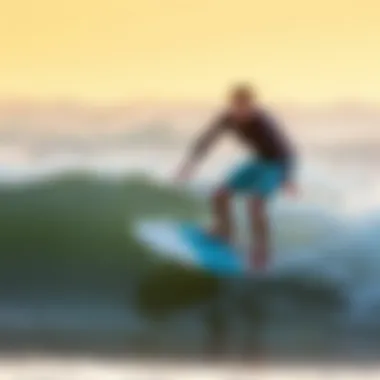
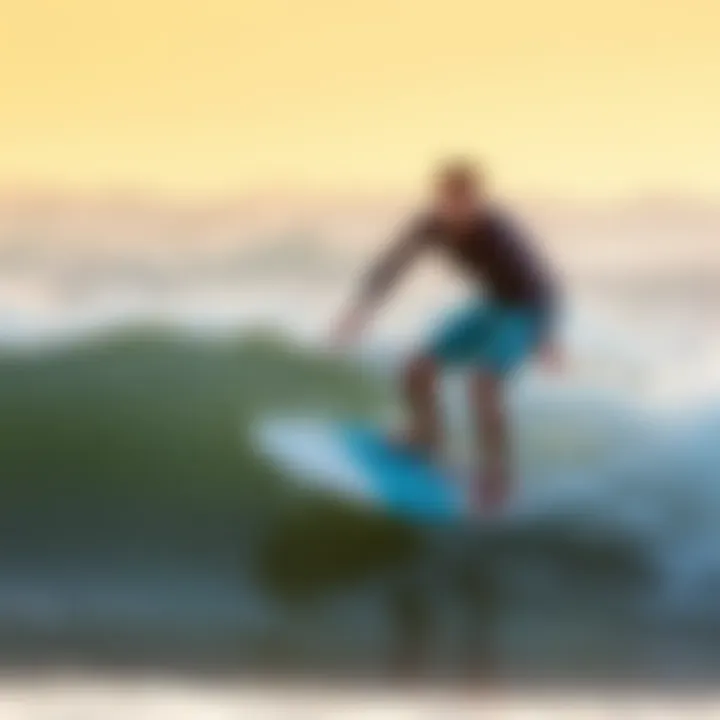
Intro
In the exhilarating world of surfboarding, understanding the dynamics of 'down wind' can be the difference between an ordinary ride and an extraordinary one. As surfers, we often find ourselves pitted against not just the waves but also the whims of the wind. It’s this invisible force that can either aid us in carving out those thrilling arcs on a wave or pose challenges we need to navigate around.
The concept of 'down wind' has immense significance in the surfing community. It holds implications for technique, safety, and the very act of navigating the ocean's unpredictable currents. Grasping how wind patterns interact with wave formation empowers surfers to harness their strengths effectively while maintaining safety on the water.
Gear and Equipment
The right equipment plays a crucial role in how surfers engage with downwind conditions. From surfboards to safety accessories, it’s nice to be well-equipped.
Latest Surfboard Technologies
Innovations in surfboard technology have transformed how we approach down wind. Many surfboards today incorporate overlaid materials, which can increase both buoyancy and responsiveness.
- Epoxy Boards: These are lighter than traditional fiberglass boards and tend to float better, giving more stability under downwind conditions.
- Hybrid Shapes: Combining features of longboards and shortboards, these boards provide versatility and ease in navigating swells.
- Fin Systems: Modern fin systems allow for quick modifications based on conditions. The ability to swap fins can significantly influence performance, especially in windswept situations.
Essential Accessories for Every Surfer
Having the right accessories can make your ride smoother and safer. Here are a few must-haves for every surfer heading into downwind conditions:
- Leashes: A strong yet flexible leash is essential to keep your board attached during wild rides.
- Impact Vests: These can protect against board impacts and increase buoyancy, ensuring safety in turbulent waters.
- Wetsuits: Depending on the temperature, a well-fitting wetsuit can prevent hypothermia while still allowing freedom of movement.
Surf Techniques and Skills
When it comes to tackling down wind, specific surfing skills can elevate the experience. Whether you’re just starting out or have been riding for a while, honing your techniques can prove invaluable.
Beginner Surfing Techniques
For newcomers, understanding the fundamentals is key. Starting with the paddling technique, it’s important to align your body with the wind direction and use it to your advantage when catching a wave. Here are essential tips for beginners:
- Positioning: Align your surfboard with the oncoming waves and apply effort in a diagonal motion toward the wave when paddling.
- Maintaining Balance: Shift your weight to stay centered on the board while adjusting for gusts and swells.
Advanced Maneuvers for Experienced Surfers
For seasoned surfers, mastering advanced techniques in downwind conditions can yield spectacular results. Experienced surfers might use the following maneuvers:
- Cutbacks: Executed by turning sharply to regain the energy of the wave while banking against the winds.
- Bottom Turns: This sets you up for an impactful maneuver, directing your board's momentum as you leave the wave's base.
**"In surfing, it’s not just about the wave; it's about the wind guiding your journey across the water's surface."
Understanding and adapting to these nuances can enhance one's ability to navigate challenging conditions while reaping the full rewards of downwind surfing. Stay tuned as we further explore the impacts of down winds on wave formations and dive into strategies for leveraging these conditions safely and effectively.
Understanding Wind Dynamics
The play of wind is not merely an accessory in the realm of surfboarding; it is a fundamental force that shapes every wave, influencing both the enjoyment and safety of surfers on the water. Understanding the nuances of wind dynamics is pivotal, as it not only improves riding performance but also enhances decision-making regarding when and where to surf. The behavior of wind directly correlates with the ocean’s surface, creating conditions that can either make or break a surf session.
The Nature of Wind
Wind is essentially air in motion, caused by the uneven heating of the Earth's surface by the sun. Different surfaces—like land, water, and vegetation—absorb and release heat at varying rates, which in turn creates pressure differences in the atmosphere. High-pressure zones push air toward low-pressure areas, generating wind.
An interesting aspect of wind is its variable nature. It can range from gentle breezes to ferocious gales. Additionally, local geographical features like hills, buildings, and even trees can affect wind patterns, leading to turbulence or obstacles. It’s vital for surfers to understand these wind behaviors, as they not only dictate wave formation but also determine the texture of the water—a smooth glassy surface may call for one type of surfing strategy, while choppy waters might require another entirely.
How Wind Affects Surf Conditions
The impact of wind on surf conditions is both critical and multifaceted. Surf conditions can be categorized based on wind direction, speed, and consistency, all of which play significant roles in the quality of the surf.
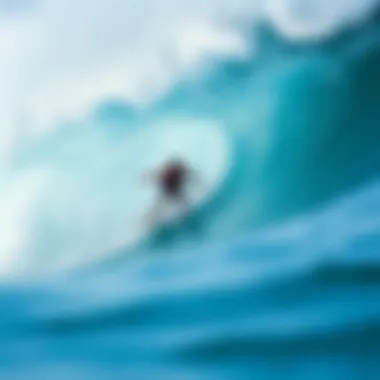
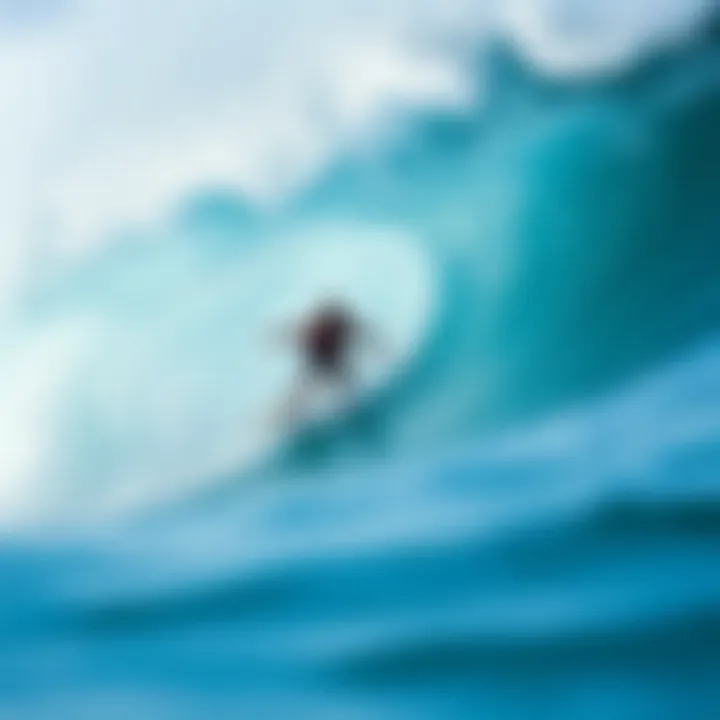
- Direction: Wind direction in relation to the waves can either enhance or degrade them. For instance, when wind blows onshore, it tends to create messy, choppy conditions. In contrast, when the wind blows offshore, it helps to shape and hold the waves, often creating more favorable surfing conditions.
- Speed: The speed of the wind also contributes to the character of the break. Powerful winds can generate larger swells, which can result in more thrilling rides, but also might escalate danger levels. Conversely, light winds may create smaller swells, ideal for beginners still honing their skills.
- Consistency: Consistency refers to how uniform the wind is over time. Steady winds that maintain the same direction help produce optimal surf states. Inconsistent gusts, however, could lead to unpredictable swells, making it harder for surfers to read the waves.
In summary, understanding wind dynamics not only elevates a surfer's ability to read the ocean but also reinforces their safety on unpredictable waters. Acknowledging these elements equips surfers with the knowledge to plan their sessions more effectively.
"The best surfer out there is the one having the most fun." - Phil Edwards
By anticipating wind patterns and their interactions with wave behavior, surfers can make informed choices about their surfing times and locations, maximizing their enjoyment and safety out in the ocean.
Defining 'Down Wind'
Understanding the term "down wind" holds pivotal significance for surfers aiming to optimize their performance and manipulate conditions in their favor. When a surfer talks about going downwind, they're not just flinging themselves into the waves; they’re tapping into the powerful forces of nature to craft a ride that’s equal parts exhilarating and efficient. This section breaks down what it truly means to go down wind and why it matters to every wave rider.
Conceptual Clarification
At its core, the concept of down wind refers to the direction towards which the wind is blowing. For surfers, riding down wind isn’t simply a casual choice; it can mean the difference between a glorious ride and a grueling slog against the elements. When surfing down wind, surfers can harness the wind’s energy to propel themselves forward, thus merging their momentum with the oceans' currents.
Consider the classic scenario of paddling out against a robust sea breeze. The surfer finds themselves fighting each stroke, battling wind resistance while trying to reach that sweet surfable zone. Now switch the narrative: entering the water with the wind at their back. With each push-off, they ride not just the waves but the wind itself. This synergy creates speed, efficiency, and a sense of fluidity that is fundamental to the art of surfing.
Terrain and Environmental Influence
The terrain of a surf spot heavily influences down wind conditions. Each beach has its unique geography, featuring dunes, cliffs, and rocks that all interact with wind patterns in different ways. For example, a beach flanked by steep cliffs might channel the wind, creating gusty conditions that help or hinder a surfer’s ride.
Factors to consider when assessing terrain include:
- Coastal Configuration: The shape and orientation of the coastline can direct winds in ways that significantly impact wave formation and surfing conditions.
- Obstructions: Natural barriers like trees or rocks can block or redirect wind, leading to sheltered areas where surfers can find calmer conditions.
- Tidal Variations: Changes in tides can impact how wind interacts with wave setups, leading to different ride dynamics throughout the day.
"A surfer's knowledge of down wind dynamics is as critical as their ability to ride the waves. It’s all interlinked, like pieces of a puzzle that form the bigger picture of surfing."
Understanding these elements is essential for surfers looking to improve their skills and navigate successfully during down wind conditions. Every wave rider, from beginners to seasoned pros, ought to embrace the intricacies of their chosen environment. By doing so, they can make informed decisions, adjusting their strategies based on real-time conditions and maximizing their surfing experiences.
Technical Aspects of Down Wind Surfboarding
Understanding the technical aspects of down wind surfboarding is crucial for surfers who are keen on optimizing their performance. Unlike typical surfing, where waves are often ridden against the wind, down wind surfing changes the game entirely. It invites surfers to harness the wind's aid, thus enhancing both speed and maneuverability.
Effects of Down Wind on Wave Behavior
When surfers venture out into down wind conditions, they encounter unique wave patterns that are greatly influenced by the wind's direction and strength. The interplay between the wind and waves can create a more favorable surfing environment, with down wind often generating smoother and faster rides.
- Wave Shape and Energy – As wind travels across the water surface, it stirs the waves differently. On the down wind, waves tend to steepen closer to the shore, allowing for larger, more powerful rides. Surfers will notice that they can gain speed with less paddling effort.
- Choppiness Reduction – On the contrary, when wind blows against the waves, it can create choppy waters making it difficult to surf effectively. In down wind conditions, however, a smooth ride is more possible, as the wind helps to mellow out the bumps created by opposing winds.
- Unique Opportunities for Tricks – The advantages of down wind surfing include the ability to practice unique tricks that might be difficult under usual surfing circumstances. Surfers can capitalize on consistent winds while executing turns and jumps, which tends to amplify the adrenaline rush.
"Riding the waves down wind is like dancing with the ocean – you and the elements move as one."
Windsurfing Techniques Relevant to Down Wind
Windsurfing offers a treasure trove of techniques that can also be applied to down wind surfboarding. Even if you are primarily a surfer, a few windsurfing strategies may just elevate your skills.
- Harnessing Wind Direction – Understand the wind direction before paddling out. If the wind is at your back, you’ll want to position yourself to catch the waves without too much strain on your balance. This requires learning to read the wind and positioning accordingly.
- Body Positioning – Leaning your body slightly forward while riding helps balance your weight with the power of the down wind. This forward posture can translate into better speed and increases overall control while catching waves.
- Sail Control – Using down wind principles can involve controlling the sail more effectively. The angle between the sail and the wind dictates speed. Angling your sail appropriately can maximize your momentum, offering not just a fast ride but also optimizing nice turns.
Incorporating these windsurfing techniques allows surfers to take full advantage of the down wind experience. It’s not just about catching waves; it’s about becoming one with them. Riders who master these skills can swiftly maneuver through variable tops of waves, exploiting every gust and current to their advantage.
Surfers ready to navigate down wind dynamics can look forward to new thrills and challenges. As they embrace the wind's influence, they're not merely surfing; they're engaging in an ever-evolving dance with nature itself.
Navigating Down Wind Conditions
Understanding how to navigate down wind effectively is crucial for surfers who wish to maximize their performance while maintaining safety. Down wind conditions significantly influence not just how a surfer rides a wave, but also the overall surfing experience. Mastering these conditions can lead to smoother rides and enhanced control. Moreover, recognizing the underlying forces at play helps surfers make informed decisions when out on the water.
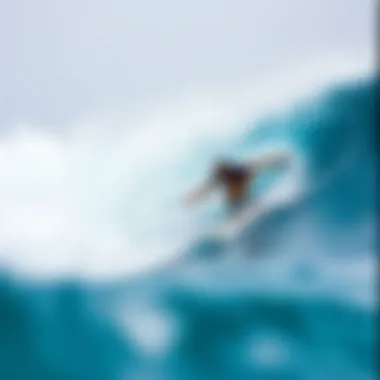
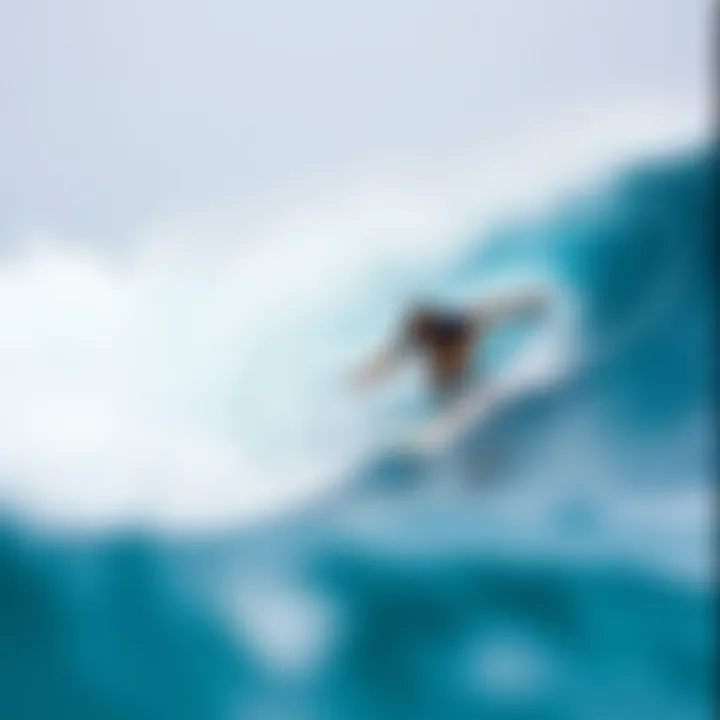
Optimal Practices for Surfers
To ride the waves like a pro in down wind conditions, certain practices are recommended:
- Positioning: Being aware of your positioning relative to the wind direction can heavily affect your ride. Make sure to angle your board appropriately to harness the wind's power without overrunning your trajectory.
- Timing: Timing is everything; waiting for the right moment creates a seamless transition as waves build. Surfers should practice patience and watch for patterns before committing to the wave.
- Body Position: Keep your knees slightly bent and your weight centered over the board. This reduces the risk of toppling over and allows for better control over your movements.
- Reading the Wind: Observing how the wind interacts with waves can be a game changer. Try to pick up on gusts and lulls. Understanding these patterns can help you choose the perfect moment to take off.
"Every wave tells a story, and wind is the narrator. If you listen closely, you can learn how to ride it better."
Adopting these practices can greatly improve a surfer's ability to navigate down wind, ensuring both performance and enjoyment.
Gear Adjustments for Down Wind Sailing
Making the right adjustments to your gear can mean the difference between a good and a great experience:
- Board Selection: Opt for a surfboard that suits down wind sailing. Boards with a wider nose can provide better stability and are less likely to nose-dive when encountering choppy conditions.
- Fins Setup: You might want to consider using larger fins for better tracking. This can help you maintain direction in strong winds and turbulent waters.
- Sails and Kites: For surfers integrating sails, selecting the proper size based on wind speed is essential. Too large a sail in strong winds can easily lead to loss of control.
- Safety Gear: Always wear a leash and consider a buoyancy aid. These pieces of gear ensure that you stay connected to your board and have an extra layer of safety.
By making these essential gear adjustments, surfers can enhance their experience while navigating down wind conditions, ensuring they are not caught off guard by changing elements.
Safety Considerations
When it comes to surfboarding, particularly in down wind conditions, safety is paramount. A solid understanding of how wind affects surfing can be the difference between a thrilling adventure and a dangerous situation. Therefore, addressing safety considerations is crucial for every surfer, whether novice or seasoned.
Weather Conditions and Alerts
Surfing in down wind scenarios often means confronting unpredictable weather patterns. Wind direction, temperature fluctuations, and emerging storms can dramatically alter the conditions on the water. Here are several points to keep in mind regarding weather conditions:
- Monitoring Wind Patterns: Use apps like Windy or local forecasts to keep track of wind speed and direction. Sudden gusts can catch you off guard, changing wave formations swiftly.
- Understanding Alerts: Pay attention to weather alerts from local authorities or dedicated websites. It's vital to have notifications set for severe weather warnings, especially when planning a surf expedition. If the outlook suggests worsening conditions, it may be wiser to postpone your outing.
- Marine Forecasts: Check coastal forecasts to see how tides and swell conditions align with expected wind patterns. Tidal influences can contribute to forming rogue waves or unpredictable rip currents.
It's not just a case of keeping your eyes on the sky; living like a sailor ensures your safety on the water.
Rescue Strategies and Techniques
Despite the best preparations, things can go wrong out there. Understanding proper rescue strategies is just as important as knowing how to ride the waves. Here’s a rundown of reliable techniques:
- Buddy System: Always surf with a partner. Look out for each other. It’s easier to ensure safety in numbers, especially in tricky down wind conditions.
- Floatation Devices: Consider carrying a buoy or a personal floatation device (PFD). This can be a lifesaver if you find yourself in sudden distress or exhausted from battling the wind.
- Signal for Help: Know the local signals for distress. If you’re in trouble, making it clear to others can expedite rescue. Wave your arms or use a whistle if you have one.
- Know Your Environment: Be familiar with the area where you're surfing. Understanding potential hazards such as rocky outcrops or currents can guide your choice of surf spots.
- Emergency Protocols: Before heading out, review emergency protocols. Whether it’s calling local Coast Guards or having a designated meeting point, being prepared can save precious minutes in times of need.
As daunting as these considerations might sound, by adopting precautionary measures, surfers can elevate their safety and enjoy their experience on the water. It’s all about riding not just the waves, but also the forces of nature with as much respect as you would afford to the ocean itself.
The Role of Geography in Down Wind Surfing
The interplay between geography and wind in surfboarding, particularly in down wind conditions, cannot be understated. Geography sets the stage for how wind behaves, and understanding this relationship can lead to more enjoyable, efficient, and safe surf experiences. The contours of coastlines, the presence of natural barriers, and the characteristics of the ocean floor significantly shape wind patterns and, in turn, the surf conditions. Recognizing these geographical influences can offer surfers insights into optimal locations and times for riding the waves downwind.
Impact of Coastal Features
Coastal features are like the stage props in a grand play, influencing how the wind sweeps across the water's surface. For instance, cliffs and headlands can funnel winds, creating stronger and more consistent gusts as they flow over the ocean. Surfers often find that spots near these coastal formations tend to have more reliable down wind conditions, making them prime locations for both beginner and experienced surfers.
- Sheltered Areas: Beaches that are tucked away behind jetties or reefs can create unique pockets of wind. Here, the wind may not be as relentless, allowing for more control when navigating the surf.
- Open Coastline: In contrast, open beaches without any protective features can lead to turbulent conditions. This might create unpredictable waves, where the wind can whip up choppy surfaces, making surfing challenging.
- Sandbars and Banks: The configuration of sandbars also plays a pivotal role. These underwater structures can affect the way waves break and how wind interacts with the water. Surf reports often highlight these features to provide better insight into down wind conditions.
Understanding the local geography not only helps in navigating the surf but also in choosing the right gear and techniques that complement the specific conditions of each location.
"Geography is not just lines on a map; it’s a canvas that defines the path of the wind and waves, shaping every surf experience."
Tidal Influences on Wind Patterns
Tide cycles can substantially influence wind patterns, creating a complex but fascinating dynamic for surfers. High and low tides affect water levels and currents, which in turn shape how wind interacts with the surface of the ocean.
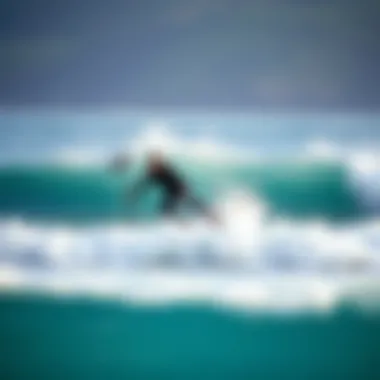
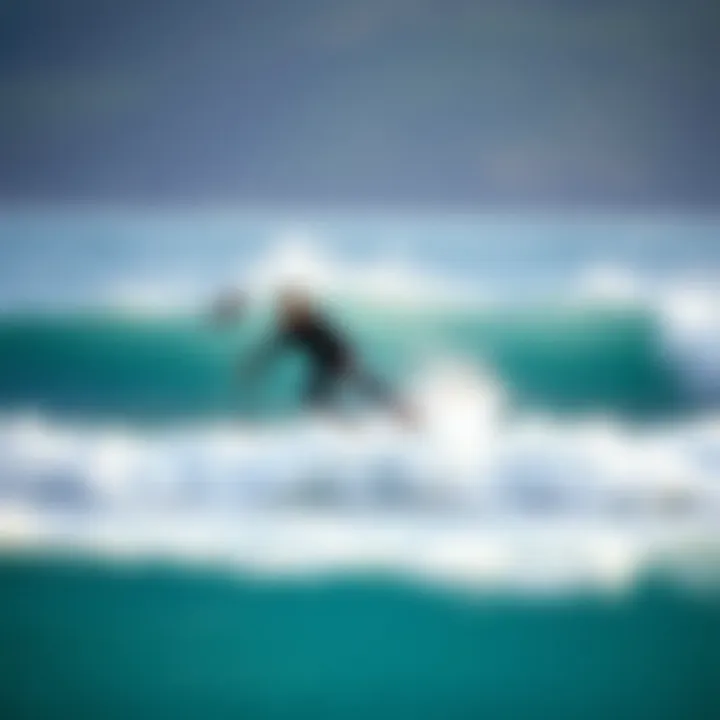
- Rising Tides: During a rising tide, water pushes against incoming waves, often enhancing their size and power. This can lead to favorable down wind conditions where the waves align ideally with the wind direction.
- Falling Tides: Conversely, falling tides can expose more surface area of the shore, changing the direction of waves and possibly altering their size. Surfers may find that down wind surfing during this phase can lead to more challenging conditions when the currents work against the prevailing winds.
- Tidal Currents: Knowledge of local tidal patterns can significantly enhance one’s surfing experience. For instance, some surfers aim to hit the water just as the tide begins to change, when down wind conditions are often optimized.
In essence, incorporating awareness of both geographical features and tidal influences is essential for surfers who want to master the art of down wind riding. Such insights help in making informed decisions about when and where to surf, paving the way for better performance and a safer surfing experience.
Lessons from Down Wind Experiences
Understanding the lessons from down wind experiences is crucial for surfers seeking to enhance their performance, safety practices, and overall enjoyment of the sport. Real-life accounts and case studies provide an invaluable lens through which to view the dynamics of down wind surfing. These experiences help surfers recognize the nuances of wind patterns, wave behavior, and the interplay of environment, allowing them to refine their techniques and develop a more intuitive approach.
Case Studies in Down Wind Surfing
Case studies serve as dynamic narratives that illustrate the challenges and triumphs experienced by surfers navigating down wind conditions. For instance, consider the scenario of a surfer at the infamous Ho'okipa Beach in Maui. Known for its powerful winds and swift currents, Ho'okipa presents a double-edged sword. A surfer who leverages the down wind properly can ride waves that propel them toward the shore effortlessly, but misjudging the wind's strength could lead to overwhelming resistance, resulting in a challenging experience.
To delve into this further, one might analyze how different surfers approached this very situation at varying skill levels.
- Beginner surfers often struggled, usually emphasizing the need to carefully observe their surroundings and learn how to listen to the wind.
- Intermediate surfers found that strategizing their lines, adjusting their speed, and anticipating waves would yield better results.
- On the other hand, advanced surfers perfectly tuned into the elements, making split-second decisions that would not only keep them safe but also allow for exhilarating rides.
These stories illustrate that the path to mastering down wind surfing is paved with both successes and missteps. Surfers benefit tremendously from analyzing these experiences, as they provide significant takeaways.
Interviews with Experienced Surfers
What better way to understand down wind dynamics than by hearing from those who’ve been around the block more than a few times? Interviews with seasoned surfers unveil a wealth of wisdom regarding individual techniques, personal experiences, and insights on what really makes the difference.
For example, John, a surfer with over two decades of experience, shared how embracing one's fears can lead to breakthroughs. "Every time the wind picks up, I remind myself that it’s an opportunity, not a hurdle. Learning to ride that force is part of the dance, and it has transformed how I surf."
Another surfer, Sara, noted the importance of regularly engaging with nature and keeping frustration at bay. Her approach emphasizes patience and a connection to the ocean; she stressed, "Every wave tells a story. I just have to stay tuned in and let the wind guide me."
Both John and Sara highlight key elements of adaptability and respect for one's surroundings, which greatly enhance a surfer's experience.
“Surfing is not just about skill; it's about understanding the rhythm of the ocean and the wind.” - Experienced Surfer
This collective wisdom provides a clear roadmap for both aspiring and experienced surfers, showcasing that lessons from down wind experiences extend beyond just technical skills. It's about developing a deep respect for the ocean and the elements, which ultimately leads to safer and more fulfilling surfing adventures.
Future Trends in Down Wind Surfing
Understanding the future trends in down wind surfing is pivotal for both avid surfers and the broader surfing community. As the sport evolves, so do the techniques, gear, and practices that adapt to changing environmental conditions and technological advancements. This section will explore how innovation and sustainability shape the future, ultimately enhancing performance and safety for surfers navigating down wind conditions.
Technological Innovations
The surfboarding realm is witnessing immense technological advancements set to transform down wind surfing. Innovations go beyond just improved boards or sails—it's about a holistic approach to surfing technology.
- Smart Boards: Some companies are integrating sensor technology into surfboards. These boards can provide real-time data about wave height, wind speed, and even tide patterns. Such feedback allows surfers to adjust their techniques while on the wave, making it an invaluable tool for improving skills in down wind conditions.
- Eco-friendly Materials: Many surfboard manufacturers are shifting towards sustainable materials. For instance, boards made from recycled plastics and bio-resins are becoming prevalent. These innovations not only lessen the environmental impact but also improve buoyancy and durability, enhancing performance during down wind rides.
- Drones for Spotting Conditions: The use of drones in surf forecasting is on the rise. These flying devices can scout wave conditions and wind patterns from above, providing surfers with information that was once hard to come by. This tech helps surfers know where the best small swells will be when sailing down wind, making for safer and more effective sessions.
As such technologies continue to develop, they pave the way for more precise and enjoyable surfing experiences in down wind conditions.
Sustainability in Surfboarding Practices
On the front of sustainability, the surfing community is increasingly focusing on practices that not only benefit the waves but also protect the oceans. As surf culture gains more visibility, the pressure on organizations and athletes to adopt sustainable practices intensifies.
- Reducing Carbon Footprint: Many surf brands are evaluating their supply chains to reduce emissions. From sourcing materials locally to adopting energy-efficient manufacturing processes, there are concerted efforts to cut down on the carbon footprint associated with surf gear production.
- Community Initiatives: Several surfing associations are forming partnerships with environmental groups to promote clean-ups at surf spots. Campaigns not only encourage surfers to maintain the health of their local waters but also raise awareness of how down wind conditions can influence debris and pollution along the coast.
- Advocacy for Ocean Health: Education plays a pivotal role in pushing for policies that protect ocean environments. Surfers are now more involved in activism, focusing on preserving coastal ecosystems that directly affect wave quality and the surfing experience.
The End
In closing, the exploration of 'down wind' within surfboarding serves as a vital aspect for surfers aiming to enhance their skills and safety on the water. Engaging with the nuances of wind dynamics fundamentally equips surfers with the knowledge needed to make informed decisions while riding waves. Understanding how the wind interacts with different coastal terrains, for instance, can give someone a leg up when positioning themselves in the water. When a surfer can effectively anticipate and leverage downwind conditions, they set themselves up for a more exhilarating experience.
Summarizing Key Points
- Wind Dynamics and Surf Conditions: Surfers need to grasp how wind influence wave formations and the overall surf experience.
- Techniques for Down Wind Surfing: Familiarity with specific maneuvers and gear adjustments helps in maximizing the benefits offered by down wind conditions.
- Safety Considerations: Awareness of weather alerts and effective rescue techniques is crucial for maintaining safety during outings.
- Geographical Influences: The unique geographical layout can affect wind patterns, which is essential knowledge for surfers aiming for optimal conditions.
- Technological Innovations: Advancements in surfing gear and technology also enable surfers to exploit downwind opportunities more effectively.
- Sustainability Practices: Upholding environmentally friendly practices within down wind surfing emphasizes the importance of our natural surroundings.
As we look toward the future, adapting to changes in surf conditions will also enhance our surfing experiences. Each surfer's journey through understanding down wind dynamics is not just about honing skills, but also about respecting and sustaining the environments where this sport thrives. For more detailed discussions and community inputs, resources like Surfline, Reddit, or Surfers Village can shed light on ongoing conversations and experiences shared among enthusiasts.
"Knowledge is the surfboard, while technique is the wave; ride them both wisely."
The synergy of these elements forms a comprehensive understanding, guiding surfers not only in their immediate endeavors but also in their broader involvement with the surf culture.







